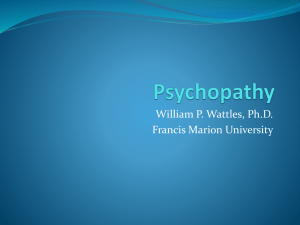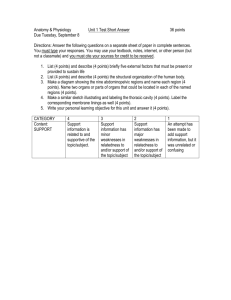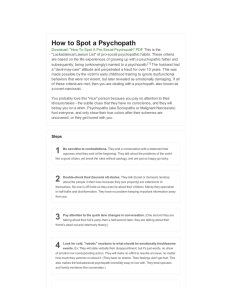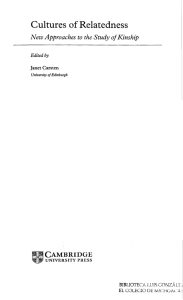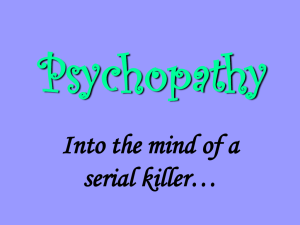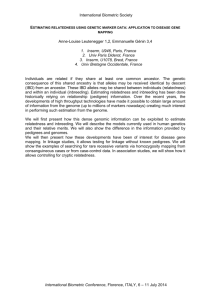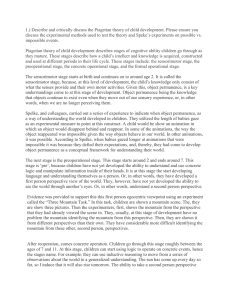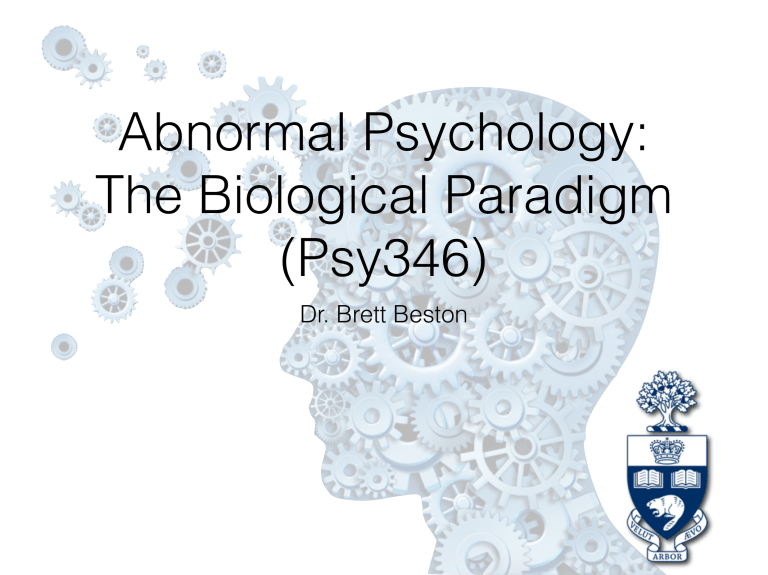
Abnormal Psychology: The Biological Paradigm (Psy346) Dr. Brett Beston Recognition Problem: Science versus Non-Science Cause and Effect Objectivity Falsifiable? How do you know what’s true? Who / what are your sources? Challenge #1 Defining Mental Disorders • Psychiatrists diagnose and categorize mental illness using the DSM-V • 400 disorders! • There have been a lot of shifting as to ‘what’ is classified as a disorder. included in DSM-V The shifting sands of the DSM American Psychiatric Association (APA) declassified homosexuality as a mental disorder in 1973. The question stands… Why was it classified as a disorder in the first place? New-Directions in Defining Disorders In DSM-IV, each of the mental disorders is conceptualized as a clinically significant behavioral or psychological syndrome or pattern that occurs in an individual and that is associated with: Challenge #2 The Research-Treament Disconnect Doctor of Psychology (PsyD) don’t have required training in research design. American Psychological Association (APA) concluded that understanding research methodology is unrelated to being a good practitioner. Therapists are free to choose their own treatment approach. Recently Introduced Therapies: Should they be used? Eye Movement Desensitization Reprogramming (EMDR) (anxiety) Recently Introduced Therapies: Should they be used? Transcranial Magnetic Stimulation (TMS) (depression) Recently Introduced Therapies: Should they be used? St. John’s wort (depression) Exploring the Biological Paradigm of Mental Health Exploring the windows of Mental health Neurobiology Genetics Development Evolution Window on Neurobiology Window on Neurobiology Window on Neurobiology Window on Neurobiology Window on Genetics Window on Evolution Evolution is a process of change in the proportion of heritable traits within a population spread over many generations What ‘lies’ ahead Enron Corporation was an American energy, commodities, and services company Fortune named Enron "America's Most Innovative Company" for six consecutive years. Enron suffered the largest Chapter 11 bankruptcy in history https://en.wikipedia.org/wiki/Enron http://people.duke.edu/~dandan/webfiles/PapersDisHonesty/The%20Dishonesty%20of.pdf The untold cost of lying $16 billion $24 billion $300 billion $600 billion The Dishonesty of Honest People Task: Find two numbers that combine to add to 10. How many of these tasks can you completed in 4 min? The Dishonesty of Honest People Does increasing reward affect cheating? So why do a lot of people cheat a little? The Dishonesty of Honest People “I understand that this short survey falls under the MIT honour code…” Does ‘risk’ affect cheating? Does the risk of ‘getting caught’ affect dishonest behaviour? 50 Multiple choice questions including… •How deep is a fathom? •What does 3! equal? •How many degrees in a triangle? •15 minutes to answer questions •$0.10 for every correct answer •Students asked to transfer answers over to scantron •three conditions Does ‘risk’ affect cheating? Does the risk of ‘getting caught’ affect dishonest behaviour? control condition solved 32.6 questions, no-recycle, recycle, and recycle* conditions solved 36.2, 35.9, and 36.1 questions The average reported performance in the three cheating conditions was significantly higher than in the control condition Evidence shows that no one dramatically cheats, so they are only cheating a small amount Does cheating affect our self-perception? ORIGINAL RESEARCH ARTICLE published: 28 August 2012 doi: 10.3389/fpsyg.2012.00305 Nepotistic patterns of violent psychopathy: evidence for adaptation? Daniel Brian Krupp 1,2,3 *, Lindsay A. Sewall 3,4 , Martin L. Lalumière 3 , Craig Sheriff 5 and Grant T. Harris 6 Department of Mathematics and Statistics, Queen’s University, Kingston, ON, Canada Department of Psychology, Neuroscience and Behaviour, McMaster University, Hamilton, ON, Canada 3 Department of Psychology, University of Lethbridge, Lethbridge, AB, Canada 4 Department of Psychology, University of Saskatchewan, Saskatoon, SK, Canada 5 Tulloch Mapping Solutions, Ottawa, ON, Canada 6 Mental Health Centre, Penetanguishene, ON, Canada 1 2 Edited by: Paul J. Watson, University of New Mexico, USA Reviewed by: Paul J. Watson, University of New Mexico, USA Elizabeth G. Pillsworth, California State University Fullerton, USA Andrea Glenn, Institute of Mental Health, Singapore, USA *Correspondence: Daniel Brian Krupp, Department of Mathematics and Statistics, Queen’s University, Jeffery Hall, Kingston, ON, Canada K7L 3N6. e-mail: daniel.krupp@queensu.ca Psychopaths routinely disregard social norms by engaging in selfish, antisocial, often violent behavior. Commonly characterized as mentally disordered, recent evidence suggests that psychopaths are executing a well-functioning, if unscrupulous strategy that historically increased reproductive success at the expense of others. Natural selection ought to have favored strategies that spared close kin from harm, however, because actions affecting the fitness of genetic relatives contribute to an individual’s inclusive fitness. Conversely, there is evidence that mental disorders can disrupt psychological mechanisms designed to protect relatives. Thus, mental disorder and adaptation accounts of psychopathy generate opposing hypotheses: psychopathy should be associated with an increase in the victimization of kin in the former account but not in the latter. Contrary to the mental disorder hypothesis, we show here in a sample of 289 violent offenders that variation in psychopathy predicts a decrease in the genetic relatedness of victims to offenders; that is, psychopathy predicts an increased likelihood of harming non-relatives. Because nepotistic inhibition in violence may be caused by dispersal or kin discrimination, we examined the effects of psychopathy on (1) the dispersal of offenders and their kin and (2) sexual assault frequency (as a window on kin discrimination). Although psychopathy was negatively associated with coresidence with kin and positively associated with the commission of sexual assault, it remained negatively associated with the genetic relatedness of victims to offenders after http://www.readcube.com/articles/10.3389/fpsyg.2012.00305 removing cases of offenders who had coresided with kin and cases of sexual assault from Antisocial Personality Disorder must be at least 15 but usually diagnosed at 18 Failure to conform to social norms Deceitfulness Impulsivity Irritability of Aggressiveness Lack of Remorse Harmful disfunction He wanted to test that: (a mechanism no longer serving its evolved function... hmmm) Think about it... • In a cooperative society, those who cheat can take advantage of a system. • Can’t have too many cheaters though, or the system doesn’t work! Psychopaths in the Population Psychopaths are rare in the population Represent 15% of prisoners. Commit half of all serious crime 1-2% What’s Unique About Psychopaths • They are not like other psychological disorders.. • Not found to be co-morbid with other disorders / mental illness (which is other wise common). • In-tact ‘Theory of Mind’ • Can detect emotions in others • Can predict vulnerability • Show behaviours that may be adaptive. How can Psychopathy exist? survival/ reproductive rate • By increasing fitness or inclusive fitness! • Many other clinical disorders show a high likely-hood of harming family. but psychopaths don’t If psychopath is adaptive... • We should see evidence of discriminate behaviour, unlike genetic kin. Experiment • Review of 400 violent offender case files. • Identified psychopaths from case files and scored on Psychopathy Checklist revised (PCL-R).need 30+ / 40 Krupp et al. Nepotistic patterns of violent psychopathy Victim-offender relatedness FIGURE 1 | Mean PCL-R score and victim-offender relatedness. The figure shows the mean PCL-R score for all offenders meeting inclusion criteria for each category of victim-offender relatedness: first-degree relatives; second-degree relatives; and non-relatives. Error bars represent standard errors of the mean. There was a significant effect of PCL-R score on victim-offender relatedness (Nagelkerke R 2 = 0.06, $2 = 17.97, p < 0.001): as PCL-R scores increased, victim-offender relatedness decreased. FIGURE 1 | Mean PCL-R score and victim-offender relatedness. The figure shows the mean PCL-R score for all offenders meeting inclusion criteria for each category of victim-offender relatedness: first-degree relatives; second-degree relatives; and non-relatives. Error bars represent standard errors of the mean. There was a significant effect of PCL-R score on victim-offender relatedness (Nagelkerke R 2 = 0.06, $2 = 17.97, p < 0.001): as PCL-R scores increased, victim-offender relatedness decreased. Psychopath dispersal FIGURE 2 | Dispersal of offender as a function of offender’s PCL-R score. The figure depicts the ranked distances that offenders dispersed from their places of birth to the locations of their index offenses against their ranked PCL-R scores. The solid line represents a linear regression line of best fit for the ranked data (r s = 0.08, p = 0.193). Evidence that psychopathology is not a disorder, but rather an adaptive strategy • less likely to harm kin • likely an increase in nepotism • Fails to support the idea that it is a disorder
